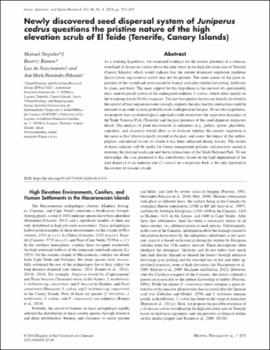Newly discovered seed dispersal system of Juniperus cedrus questions the pristine nature of the high elevation scrub of El Teide (Tenerife, Canary Islands)
Date
2014Abstract
As a working hypothesis, we examined evidence for the former presence of a climacic
woodland of Juniperus cedrus above the pine forest in the high elevation area of Tenerife
(Canary Islands), which would indicate that the current dominant vegetation (endemic
Spartocytisus supranubius scrub) may not be pristine. The main causes of the great regression
of this woodland were caused by human activities (timber harvesting, herbivory
by goats, and fires). The main support for this hypothesis is the survival of a presumably
relict seed dispersal system of the endangered endemic J. cedrus, which relies mainly on
the wintering thrush Turdus torquatus. The fact that genetic factors are directly involved in
the control of bird migration routes strongly supports the idea that this interaction could be
remnant of an older system, probably more widespread in the past. To test this hypothesis,
we propose that a paleoecological approach could reconstruct the vegetation dynamics in
the Teide National Park (Tenerife) and the past presence of this seed disperser migratory
thrush. The analysis of plant microfossils in sediments (e.g., pollen, spores, phytoliths,
coprolites, and charcoal) would allow us to evaluate whether the current vegetation is
the same as that which naturally existed in the past, and assess the impact of the anthropogenic
and natural factors to which it has been subjected during history. The results
of these analyses will be useful for future management policies and practices aimed at
restoring the pristine landscape and biotic interactions of the Teide National Park. To our
knowledge, the case presented in this contribution, based on the high dependence of the
seed dispersal of an endemic tree (J. cedrus) on a migratory bird, is the only reported in
the context of oceanic islands.






